Analysis of Qualitative Research in Public Health: A Detailed Report
VerifiedAdded on 2020/03/04
|7
|2170
|136
Report
AI Summary
This report provides a comprehensive analysis of a qualitative research study conducted in Victoria, Australia, examining the motivations and decision-making processes of both indigenous and non-indigenous participants in public health research. The study addresses the social problem of potential exploitation in research, exploring differences in responses, motivating factors for participation, and challenges faced by researchers. The research adopts a constructivist paradigm, utilizing interviews to gather data on participants' opinions and attitudes. The sample consists of 36 participants, with a focus on ethical considerations, including obtaining consent and protecting participant identities. The findings reveal discrepancies in motivation between indigenous and non-indigenous participants, highlighting the importance of ethical practices and the potential for selection bias. The report concludes with recommendations for future studies, emphasizing the need for culturally sensitive approaches and the importance of addressing potential research biases. This report contributes to the understanding of ethical research practices and participant experiences in public health settings.
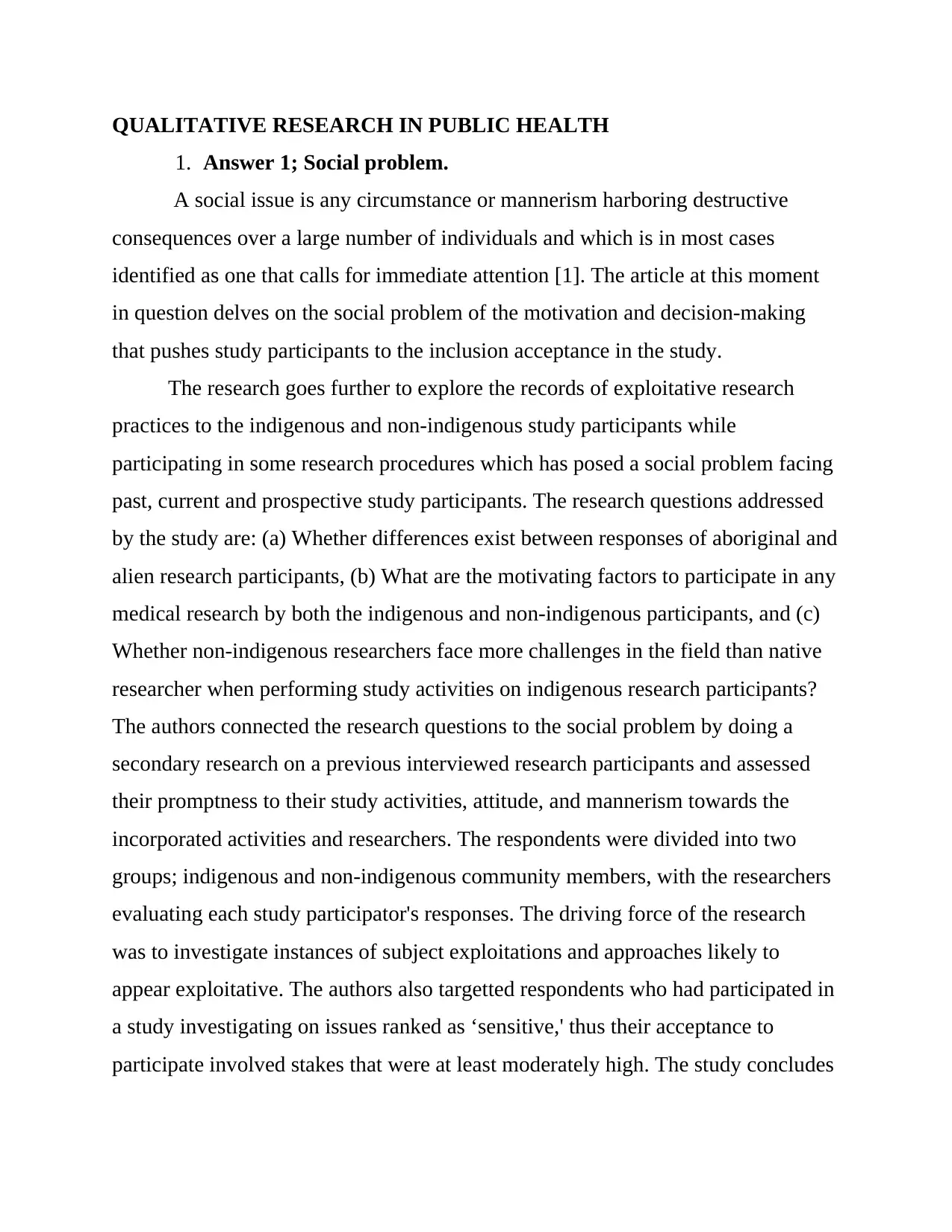
QUALITATIVE RESEARCH IN PUBLIC HEALTH
1. Answer 1; Social problem.
A social issue is any circumstance or mannerism harboring destructive
consequences over a large number of individuals and which is in most cases
identified as one that calls for immediate attention [1]. The article at this moment
in question delves on the social problem of the motivation and decision-making
that pushes study participants to the inclusion acceptance in the study.
The research goes further to explore the records of exploitative research
practices to the indigenous and non-indigenous study participants while
participating in some research procedures which has posed a social problem facing
past, current and prospective study participants. The research questions addressed
by the study are: (a) Whether differences exist between responses of aboriginal and
alien research participants, (b) What are the motivating factors to participate in any
medical research by both the indigenous and non-indigenous participants, and (c)
Whether non-indigenous researchers face more challenges in the field than native
researcher when performing study activities on indigenous research participants?
The authors connected the research questions to the social problem by doing a
secondary research on a previous interviewed research participants and assessed
their promptness to their study activities, attitude, and mannerism towards the
incorporated activities and researchers. The respondents were divided into two
groups; indigenous and non-indigenous community members, with the researchers
evaluating each study participator's responses. The driving force of the research
was to investigate instances of subject exploitations and approaches likely to
appear exploitative. The authors also targetted respondents who had participated in
a study investigating on issues ranked as ‘sensitive,' thus their acceptance to
participate involved stakes that were at least moderately high. The study concludes
1. Answer 1; Social problem.
A social issue is any circumstance or mannerism harboring destructive
consequences over a large number of individuals and which is in most cases
identified as one that calls for immediate attention [1]. The article at this moment
in question delves on the social problem of the motivation and decision-making
that pushes study participants to the inclusion acceptance in the study.
The research goes further to explore the records of exploitative research
practices to the indigenous and non-indigenous study participants while
participating in some research procedures which has posed a social problem facing
past, current and prospective study participants. The research questions addressed
by the study are: (a) Whether differences exist between responses of aboriginal and
alien research participants, (b) What are the motivating factors to participate in any
medical research by both the indigenous and non-indigenous participants, and (c)
Whether non-indigenous researchers face more challenges in the field than native
researcher when performing study activities on indigenous research participants?
The authors connected the research questions to the social problem by doing a
secondary research on a previous interviewed research participants and assessed
their promptness to their study activities, attitude, and mannerism towards the
incorporated activities and researchers. The respondents were divided into two
groups; indigenous and non-indigenous community members, with the researchers
evaluating each study participator's responses. The driving force of the research
was to investigate instances of subject exploitations and approaches likely to
appear exploitative. The authors also targetted respondents who had participated in
a study investigating on issues ranked as ‘sensitive,' thus their acceptance to
participate involved stakes that were at least moderately high. The study concludes
Paraphrase This Document
Need a fresh take? Get an instant paraphrase of this document with our AI Paraphraser
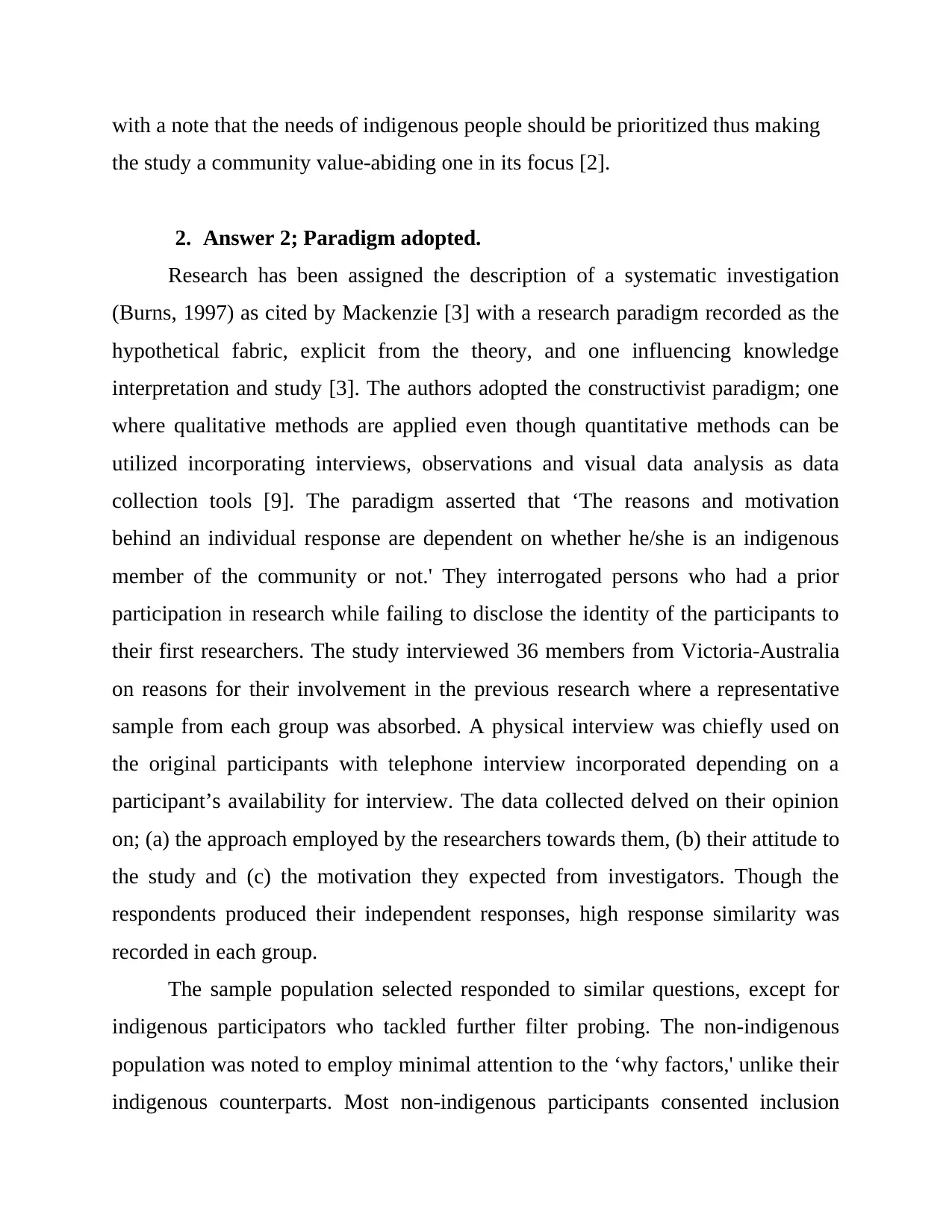
with a note that the needs of indigenous people should be prioritized thus making
the study a community value-abiding one in its focus [2].
2. Answer 2; Paradigm adopted.
Research has been assigned the description of a systematic investigation
(Burns, 1997) as cited by Mackenzie [3] with a research paradigm recorded as the
hypothetical fabric, explicit from the theory, and one influencing knowledge
interpretation and study [3]. The authors adopted the constructivist paradigm; one
where qualitative methods are applied even though quantitative methods can be
utilized incorporating interviews, observations and visual data analysis as data
collection tools [9]. The paradigm asserted that ‘The reasons and motivation
behind an individual response are dependent on whether he/she is an indigenous
member of the community or not.' They interrogated persons who had a prior
participation in research while failing to disclose the identity of the participants to
their first researchers. The study interviewed 36 members from Victoria-Australia
on reasons for their involvement in the previous research where a representative
sample from each group was absorbed. A physical interview was chiefly used on
the original participants with telephone interview incorporated depending on a
participant’s availability for interview. The data collected delved on their opinion
on; (a) the approach employed by the researchers towards them, (b) their attitude to
the study and (c) the motivation they expected from investigators. Though the
respondents produced their independent responses, high response similarity was
recorded in each group.
The sample population selected responded to similar questions, except for
indigenous participators who tackled further filter probing. The non-indigenous
population was noted to employ minimal attention to the ‘why factors,' unlike their
indigenous counterparts. Most non-indigenous participants consented inclusion
the study a community value-abiding one in its focus [2].
2. Answer 2; Paradigm adopted.
Research has been assigned the description of a systematic investigation
(Burns, 1997) as cited by Mackenzie [3] with a research paradigm recorded as the
hypothetical fabric, explicit from the theory, and one influencing knowledge
interpretation and study [3]. The authors adopted the constructivist paradigm; one
where qualitative methods are applied even though quantitative methods can be
utilized incorporating interviews, observations and visual data analysis as data
collection tools [9]. The paradigm asserted that ‘The reasons and motivation
behind an individual response are dependent on whether he/she is an indigenous
member of the community or not.' They interrogated persons who had a prior
participation in research while failing to disclose the identity of the participants to
their first researchers. The study interviewed 36 members from Victoria-Australia
on reasons for their involvement in the previous research where a representative
sample from each group was absorbed. A physical interview was chiefly used on
the original participants with telephone interview incorporated depending on a
participant’s availability for interview. The data collected delved on their opinion
on; (a) the approach employed by the researchers towards them, (b) their attitude to
the study and (c) the motivation they expected from investigators. Though the
respondents produced their independent responses, high response similarity was
recorded in each group.
The sample population selected responded to similar questions, except for
indigenous participators who tackled further filter probing. The non-indigenous
population was noted to employ minimal attention to the ‘why factors,' unlike their
indigenous counterparts. Most non-indigenous participants consented inclusion
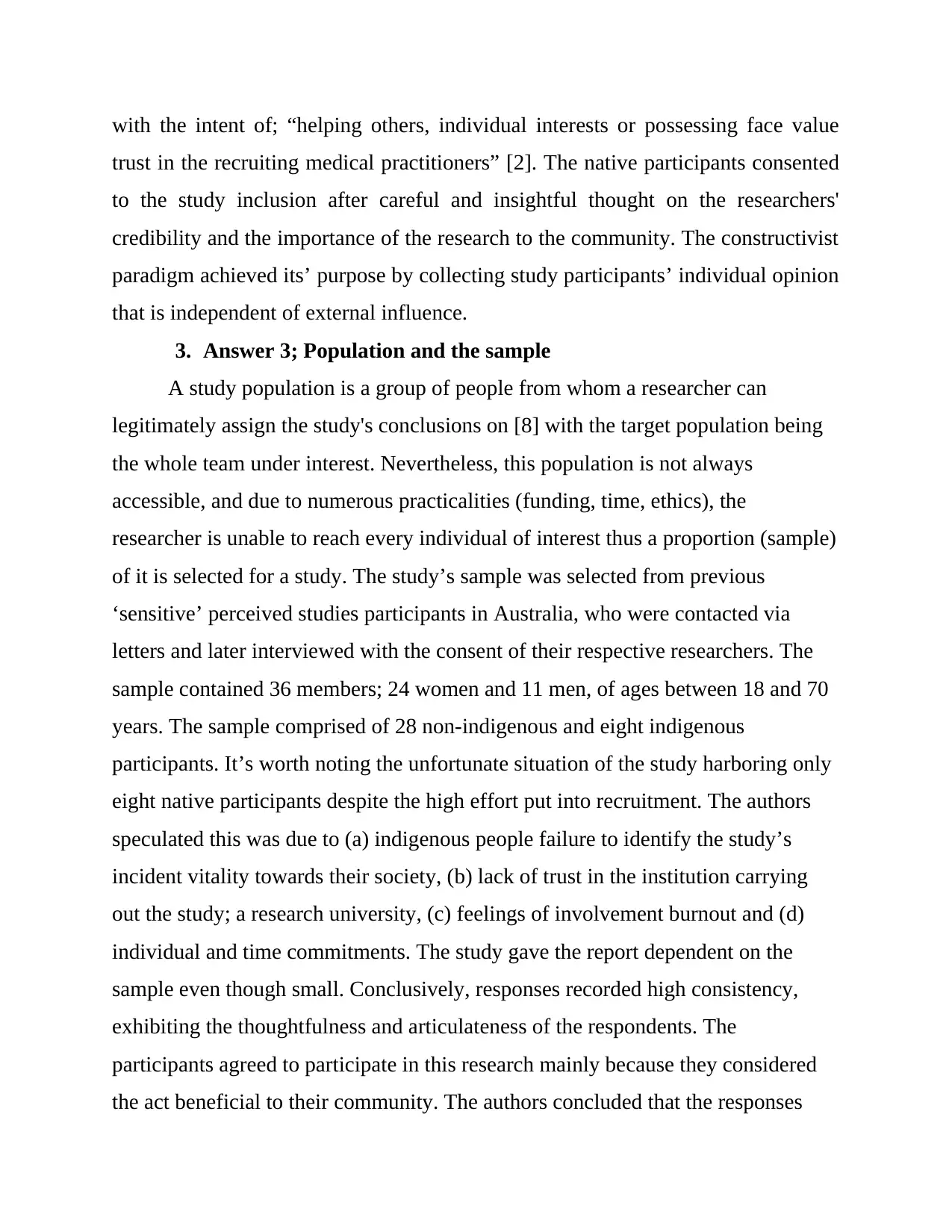
with the intent of; “helping others, individual interests or possessing face value
trust in the recruiting medical practitioners” [2]. The native participants consented
to the study inclusion after careful and insightful thought on the researchers'
credibility and the importance of the research to the community. The constructivist
paradigm achieved its’ purpose by collecting study participants’ individual opinion
that is independent of external influence.
3. Answer 3; Population and the sample
A study population is a group of people from whom a researcher can
legitimately assign the study's conclusions on [8] with the target population being
the whole team under interest. Nevertheless, this population is not always
accessible, and due to numerous practicalities (funding, time, ethics), the
researcher is unable to reach every individual of interest thus a proportion (sample)
of it is selected for a study. The study’s sample was selected from previous
‘sensitive’ perceived studies participants in Australia, who were contacted via
letters and later interviewed with the consent of their respective researchers. The
sample contained 36 members; 24 women and 11 men, of ages between 18 and 70
years. The sample comprised of 28 non-indigenous and eight indigenous
participants. It’s worth noting the unfortunate situation of the study harboring only
eight native participants despite the high effort put into recruitment. The authors
speculated this was due to (a) indigenous people failure to identify the study’s
incident vitality towards their society, (b) lack of trust in the institution carrying
out the study; a research university, (c) feelings of involvement burnout and (d)
individual and time commitments. The study gave the report dependent on the
sample even though small. Conclusively, responses recorded high consistency,
exhibiting the thoughtfulness and articulateness of the respondents. The
participants agreed to participate in this research mainly because they considered
the act beneficial to their community. The authors concluded that the responses
trust in the recruiting medical practitioners” [2]. The native participants consented
to the study inclusion after careful and insightful thought on the researchers'
credibility and the importance of the research to the community. The constructivist
paradigm achieved its’ purpose by collecting study participants’ individual opinion
that is independent of external influence.
3. Answer 3; Population and the sample
A study population is a group of people from whom a researcher can
legitimately assign the study's conclusions on [8] with the target population being
the whole team under interest. Nevertheless, this population is not always
accessible, and due to numerous practicalities (funding, time, ethics), the
researcher is unable to reach every individual of interest thus a proportion (sample)
of it is selected for a study. The study’s sample was selected from previous
‘sensitive’ perceived studies participants in Australia, who were contacted via
letters and later interviewed with the consent of their respective researchers. The
sample contained 36 members; 24 women and 11 men, of ages between 18 and 70
years. The sample comprised of 28 non-indigenous and eight indigenous
participants. It’s worth noting the unfortunate situation of the study harboring only
eight native participants despite the high effort put into recruitment. The authors
speculated this was due to (a) indigenous people failure to identify the study’s
incident vitality towards their society, (b) lack of trust in the institution carrying
out the study; a research university, (c) feelings of involvement burnout and (d)
individual and time commitments. The study gave the report dependent on the
sample even though small. Conclusively, responses recorded high consistency,
exhibiting the thoughtfulness and articulateness of the respondents. The
participants agreed to participate in this research mainly because they considered
the act beneficial to their community. The authors concluded that the responses
⊘ This is a preview!⊘
Do you want full access?
Subscribe today to unlock all pages.

Trusted by 1+ million students worldwide
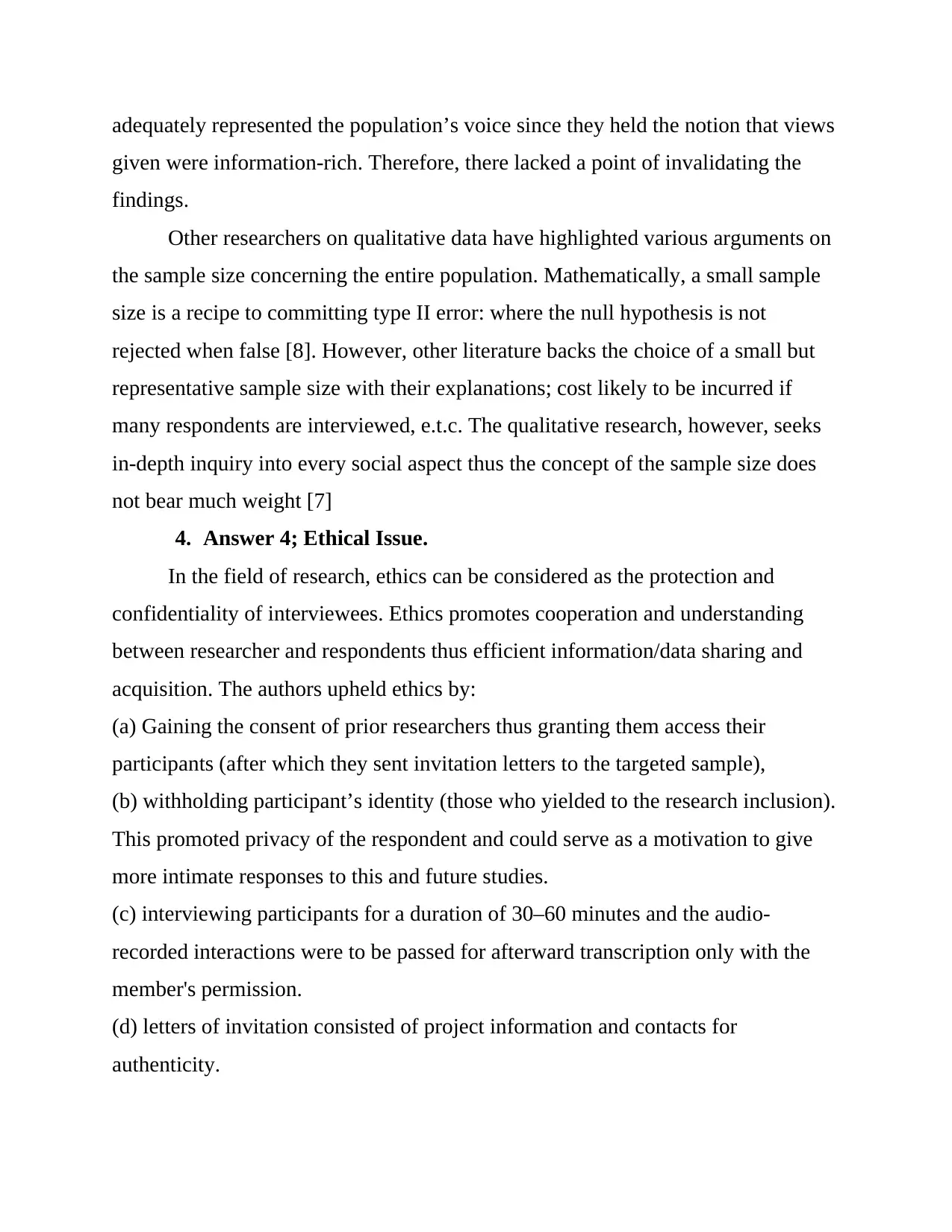
adequately represented the population’s voice since they held the notion that views
given were information-rich. Therefore, there lacked a point of invalidating the
findings.
Other researchers on qualitative data have highlighted various arguments on
the sample size concerning the entire population. Mathematically, a small sample
size is a recipe to committing type II error: where the null hypothesis is not
rejected when false [8]. However, other literature backs the choice of a small but
representative sample size with their explanations; cost likely to be incurred if
many respondents are interviewed, e.t.c. The qualitative research, however, seeks
in-depth inquiry into every social aspect thus the concept of the sample size does
not bear much weight [7]
4. Answer 4; Ethical Issue.
In the field of research, ethics can be considered as the protection and
confidentiality of interviewees. Ethics promotes cooperation and understanding
between researcher and respondents thus efficient information/data sharing and
acquisition. The authors upheld ethics by:
(a) Gaining the consent of prior researchers thus granting them access their
participants (after which they sent invitation letters to the targeted sample),
(b) withholding participant’s identity (those who yielded to the research inclusion).
This promoted privacy of the respondent and could serve as a motivation to give
more intimate responses to this and future studies.
(c) interviewing participants for a duration of 30–60 minutes and the audio-
recorded interactions were to be passed for afterward transcription only with the
member's permission.
(d) letters of invitation consisted of project information and contacts for
authenticity.
given were information-rich. Therefore, there lacked a point of invalidating the
findings.
Other researchers on qualitative data have highlighted various arguments on
the sample size concerning the entire population. Mathematically, a small sample
size is a recipe to committing type II error: where the null hypothesis is not
rejected when false [8]. However, other literature backs the choice of a small but
representative sample size with their explanations; cost likely to be incurred if
many respondents are interviewed, e.t.c. The qualitative research, however, seeks
in-depth inquiry into every social aspect thus the concept of the sample size does
not bear much weight [7]
4. Answer 4; Ethical Issue.
In the field of research, ethics can be considered as the protection and
confidentiality of interviewees. Ethics promotes cooperation and understanding
between researcher and respondents thus efficient information/data sharing and
acquisition. The authors upheld ethics by:
(a) Gaining the consent of prior researchers thus granting them access their
participants (after which they sent invitation letters to the targeted sample),
(b) withholding participant’s identity (those who yielded to the research inclusion).
This promoted privacy of the respondent and could serve as a motivation to give
more intimate responses to this and future studies.
(c) interviewing participants for a duration of 30–60 minutes and the audio-
recorded interactions were to be passed for afterward transcription only with the
member's permission.
(d) letters of invitation consisted of project information and contacts for
authenticity.
Paraphrase This Document
Need a fresh take? Get an instant paraphrase of this document with our AI Paraphraser
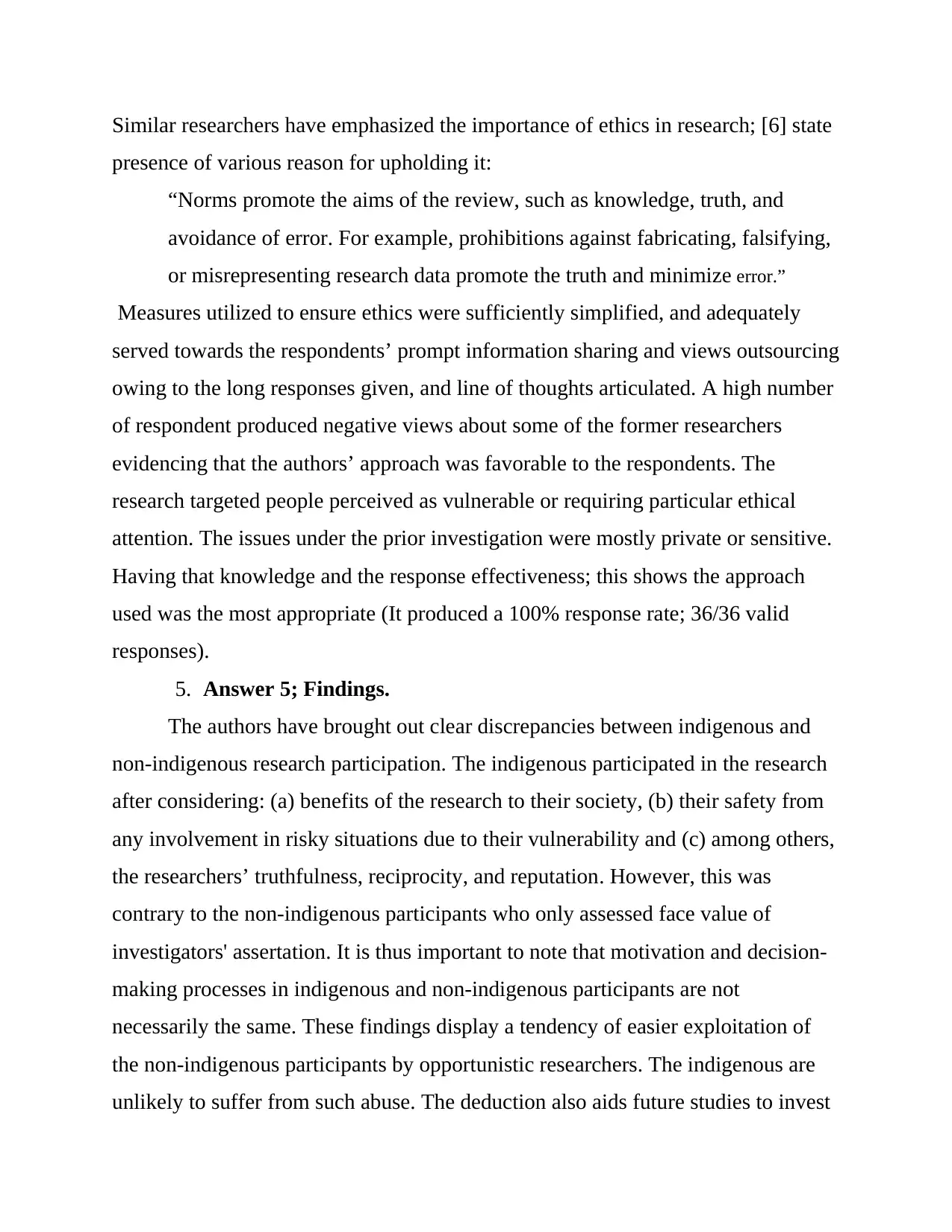
Similar researchers have emphasized the importance of ethics in research; [6] state
presence of various reason for upholding it:
“Norms promote the aims of the review, such as knowledge, truth, and
avoidance of error. For example, prohibitions against fabricating, falsifying,
or misrepresenting research data promote the truth and minimize error.”
Measures utilized to ensure ethics were sufficiently simplified, and adequately
served towards the respondents’ prompt information sharing and views outsourcing
owing to the long responses given, and line of thoughts articulated. A high number
of respondent produced negative views about some of the former researchers
evidencing that the authors’ approach was favorable to the respondents. The
research targeted people perceived as vulnerable or requiring particular ethical
attention. The issues under the prior investigation were mostly private or sensitive.
Having that knowledge and the response effectiveness; this shows the approach
used was the most appropriate (It produced a 100% response rate; 36/36 valid
responses).
5. Answer 5; Findings.
The authors have brought out clear discrepancies between indigenous and
non-indigenous research participation. The indigenous participated in the research
after considering: (a) benefits of the research to their society, (b) their safety from
any involvement in risky situations due to their vulnerability and (c) among others,
the researchers’ truthfulness, reciprocity, and reputation. However, this was
contrary to the non-indigenous participants who only assessed face value of
investigators' assertation. It is thus important to note that motivation and decision-
making processes in indigenous and non-indigenous participants are not
necessarily the same. These findings display a tendency of easier exploitation of
the non-indigenous participants by opportunistic researchers. The indigenous are
unlikely to suffer from such abuse. The deduction also aids future studies to invest
presence of various reason for upholding it:
“Norms promote the aims of the review, such as knowledge, truth, and
avoidance of error. For example, prohibitions against fabricating, falsifying,
or misrepresenting research data promote the truth and minimize error.”
Measures utilized to ensure ethics were sufficiently simplified, and adequately
served towards the respondents’ prompt information sharing and views outsourcing
owing to the long responses given, and line of thoughts articulated. A high number
of respondent produced negative views about some of the former researchers
evidencing that the authors’ approach was favorable to the respondents. The
research targeted people perceived as vulnerable or requiring particular ethical
attention. The issues under the prior investigation were mostly private or sensitive.
Having that knowledge and the response effectiveness; this shows the approach
used was the most appropriate (It produced a 100% response rate; 36/36 valid
responses).
5. Answer 5; Findings.
The authors have brought out clear discrepancies between indigenous and
non-indigenous research participation. The indigenous participated in the research
after considering: (a) benefits of the research to their society, (b) their safety from
any involvement in risky situations due to their vulnerability and (c) among others,
the researchers’ truthfulness, reciprocity, and reputation. However, this was
contrary to the non-indigenous participants who only assessed face value of
investigators' assertation. It is thus important to note that motivation and decision-
making processes in indigenous and non-indigenous participants are not
necessarily the same. These findings display a tendency of easier exploitation of
the non-indigenous participants by opportunistic researchers. The indigenous are
unlikely to suffer from such abuse. The deduction also aids future studies to invest
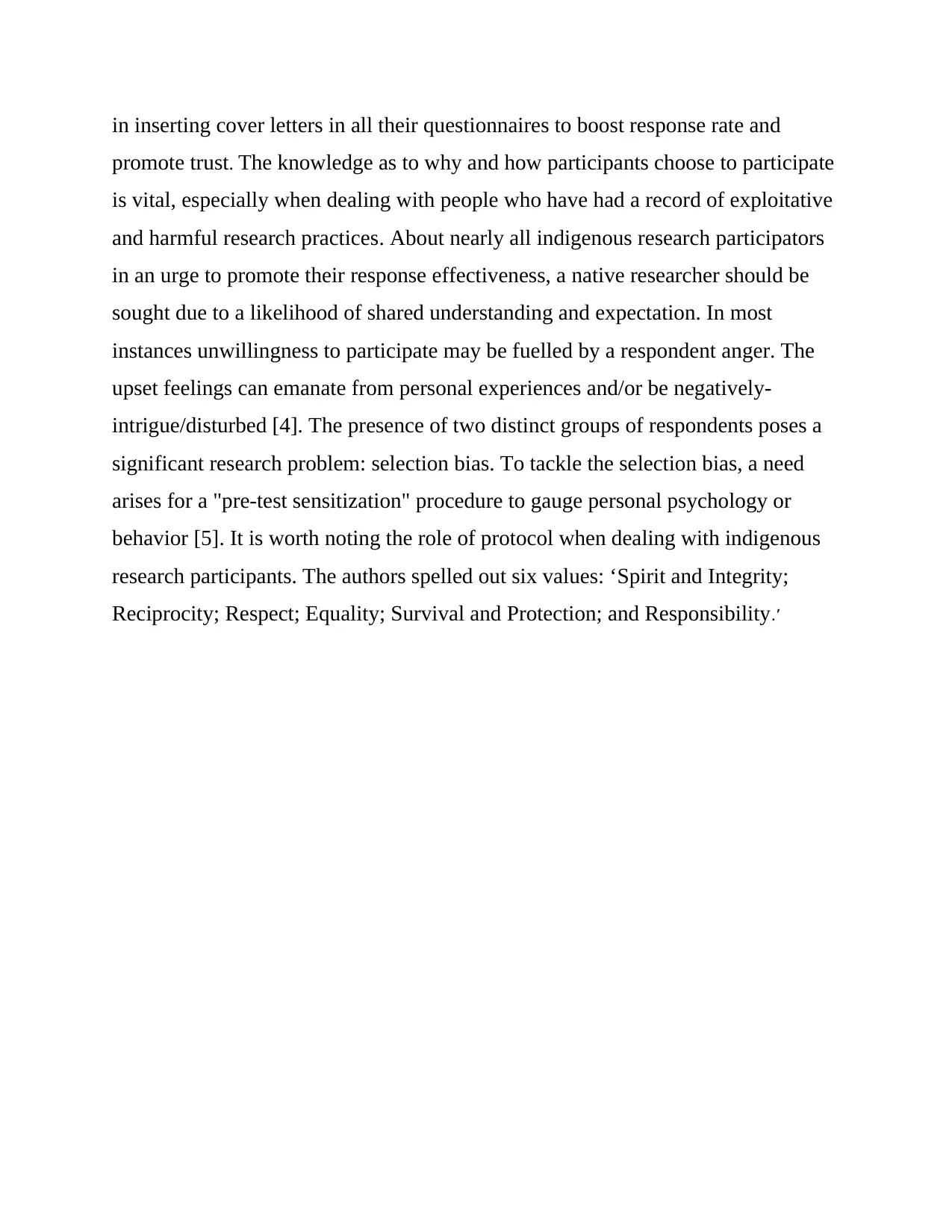
in inserting cover letters in all their questionnaires to boost response rate and
promote trust. The knowledge as to why and how participants choose to participate
is vital, especially when dealing with people who have had a record of exploitative
and harmful research practices. About nearly all indigenous research participators
in an urge to promote their response effectiveness, a native researcher should be
sought due to a likelihood of shared understanding and expectation. In most
instances unwillingness to participate may be fuelled by a respondent anger. The
upset feelings can emanate from personal experiences and/or be negatively-
intrigue/disturbed [4]. The presence of two distinct groups of respondents poses a
significant research problem: selection bias. To tackle the selection bias, a need
arises for a "pre-test sensitization" procedure to gauge personal psychology or
behavior [5]. It is worth noting the role of protocol when dealing with indigenous
research participants. The authors spelled out six values: ‘Spirit and Integrity;
Reciprocity; Respect; Equality; Survival and Protection; and Responsibility.’
promote trust. The knowledge as to why and how participants choose to participate
is vital, especially when dealing with people who have had a record of exploitative
and harmful research practices. About nearly all indigenous research participators
in an urge to promote their response effectiveness, a native researcher should be
sought due to a likelihood of shared understanding and expectation. In most
instances unwillingness to participate may be fuelled by a respondent anger. The
upset feelings can emanate from personal experiences and/or be negatively-
intrigue/disturbed [4]. The presence of two distinct groups of respondents poses a
significant research problem: selection bias. To tackle the selection bias, a need
arises for a "pre-test sensitization" procedure to gauge personal psychology or
behavior [5]. It is worth noting the role of protocol when dealing with indigenous
research participants. The authors spelled out six values: ‘Spirit and Integrity;
Reciprocity; Respect; Equality; Survival and Protection; and Responsibility.’
⊘ This is a preview!⊘
Do you want full access?
Subscribe today to unlock all pages.

Trusted by 1+ million students worldwide
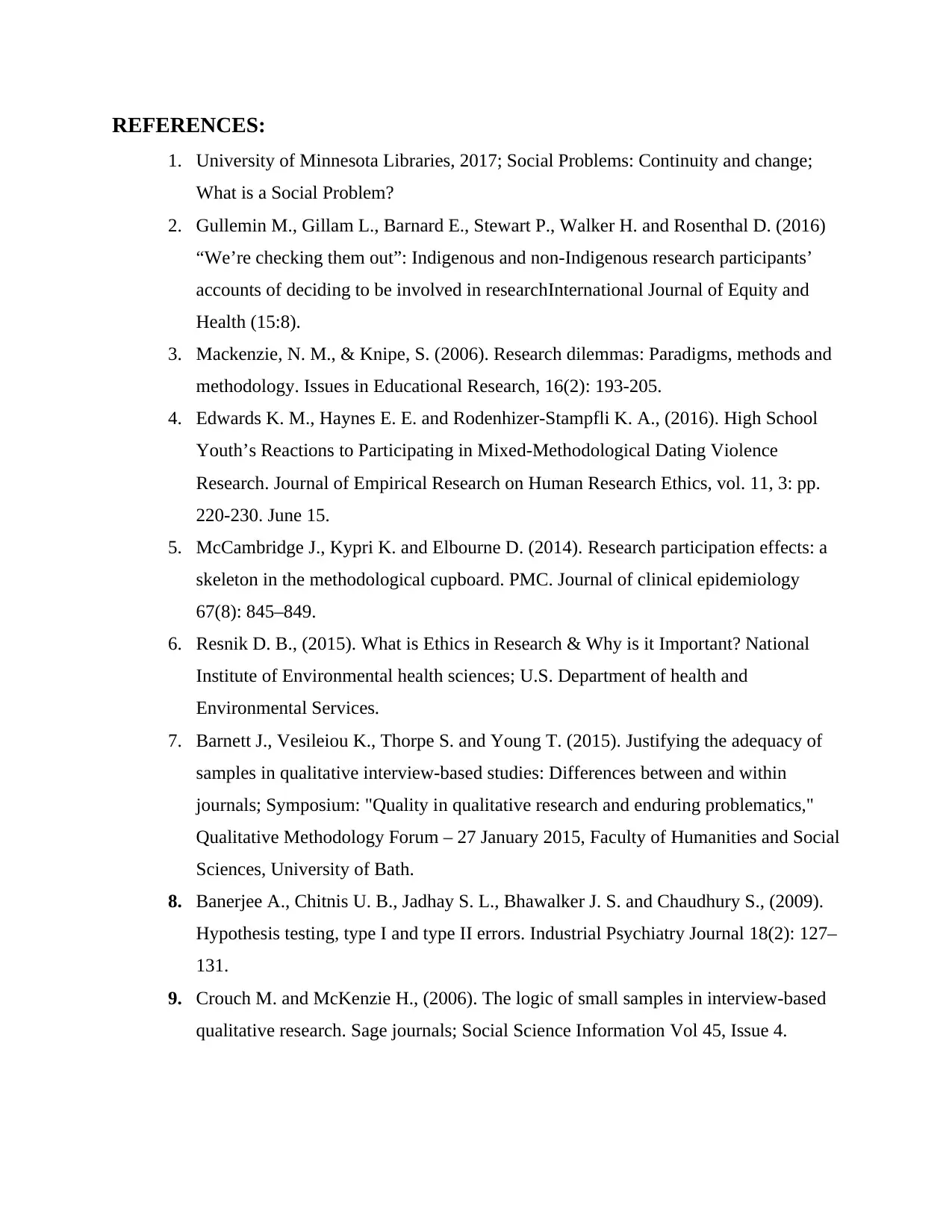
REFERENCES:
1. University of Minnesota Libraries, 2017; Social Problems: Continuity and change;
What is a Social Problem?
2. Gullemin M., Gillam L., Barnard E., Stewart P., Walker H. and Rosenthal D. (2016)
“We’re checking them out”: Indigenous and non-Indigenous research participants’
accounts of deciding to be involved in researchInternational Journal of Equity and
Health (15:8).
3. Mackenzie, N. M., & Knipe, S. (2006). Research dilemmas: Paradigms, methods and
methodology. Issues in Educational Research, 16(2): 193-205.
4. Edwards K. M., Haynes E. E. and Rodenhizer-Stampfli K. A., (2016). High School
Youth’s Reactions to Participating in Mixed-Methodological Dating Violence
Research. Journal of Empirical Research on Human Research Ethics, vol. 11, 3: pp.
220-230. June 15.
5. McCambridge J., Kypri K. and Elbourne D. (2014). Research participation effects: a
skeleton in the methodological cupboard. PMC. Journal of clinical epidemiology
67(8): 845–849.
6. Resnik D. B., (2015). What is Ethics in Research & Why is it Important? National
Institute of Environmental health sciences; U.S. Department of health and
Environmental Services.
7. Barnett J., Vesileiou K., Thorpe S. and Young T. (2015). Justifying the adequacy of
samples in qualitative interview-based studies: Differences between and within
journals; Symposium: "Quality in qualitative research and enduring problematics,"
Qualitative Methodology Forum – 27 January 2015, Faculty of Humanities and Social
Sciences, University of Bath.
8. Banerjee A., Chitnis U. B., Jadhay S. L., Bhawalker J. S. and Chaudhury S., (2009).
Hypothesis testing, type I and type II errors. Industrial Psychiatry Journal 18(2): 127–
131.
9. Crouch M. and McKenzie H., (2006). The logic of small samples in interview-based
qualitative research. Sage journals; Social Science Information Vol 45, Issue 4.
1. University of Minnesota Libraries, 2017; Social Problems: Continuity and change;
What is a Social Problem?
2. Gullemin M., Gillam L., Barnard E., Stewart P., Walker H. and Rosenthal D. (2016)
“We’re checking them out”: Indigenous and non-Indigenous research participants’
accounts of deciding to be involved in researchInternational Journal of Equity and
Health (15:8).
3. Mackenzie, N. M., & Knipe, S. (2006). Research dilemmas: Paradigms, methods and
methodology. Issues in Educational Research, 16(2): 193-205.
4. Edwards K. M., Haynes E. E. and Rodenhizer-Stampfli K. A., (2016). High School
Youth’s Reactions to Participating in Mixed-Methodological Dating Violence
Research. Journal of Empirical Research on Human Research Ethics, vol. 11, 3: pp.
220-230. June 15.
5. McCambridge J., Kypri K. and Elbourne D. (2014). Research participation effects: a
skeleton in the methodological cupboard. PMC. Journal of clinical epidemiology
67(8): 845–849.
6. Resnik D. B., (2015). What is Ethics in Research & Why is it Important? National
Institute of Environmental health sciences; U.S. Department of health and
Environmental Services.
7. Barnett J., Vesileiou K., Thorpe S. and Young T. (2015). Justifying the adequacy of
samples in qualitative interview-based studies: Differences between and within
journals; Symposium: "Quality in qualitative research and enduring problematics,"
Qualitative Methodology Forum – 27 January 2015, Faculty of Humanities and Social
Sciences, University of Bath.
8. Banerjee A., Chitnis U. B., Jadhay S. L., Bhawalker J. S. and Chaudhury S., (2009).
Hypothesis testing, type I and type II errors. Industrial Psychiatry Journal 18(2): 127–
131.
9. Crouch M. and McKenzie H., (2006). The logic of small samples in interview-based
qualitative research. Sage journals; Social Science Information Vol 45, Issue 4.
1 out of 7
Related Documents
Your All-in-One AI-Powered Toolkit for Academic Success.
+13062052269
info@desklib.com
Available 24*7 on WhatsApp / Email
![[object Object]](/_next/static/media/star-bottom.7253800d.svg)
Unlock your academic potential
Copyright © 2020–2025 A2Z Services. All Rights Reserved. Developed and managed by ZUCOL.





